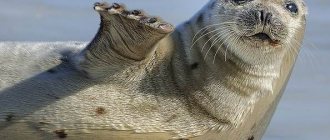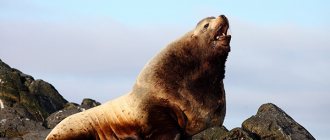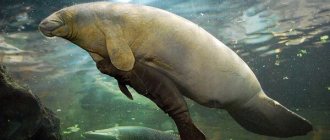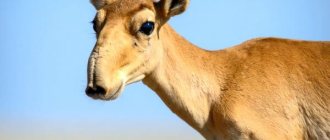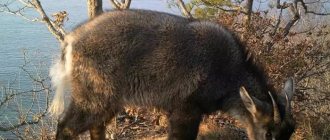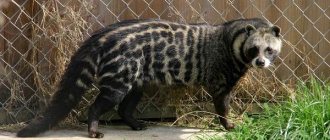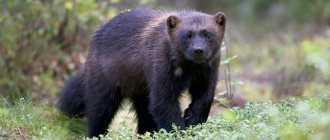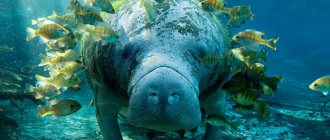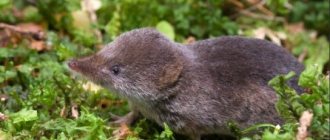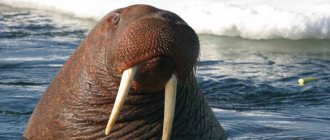Seals are animals belonging to the order Pinnipeds. There are about 35 species in this order, but in Russia you can find about 15. Body length can vary from one and a half meters to 6, and weight from a hundredweight to several tons. That is, seals are usually medium in size. Their body is cigar-shaped, their legs are represented by flippers and they have developed nails. There are no external ears. They can move only on their belly; they also use it when swimming. They are semi-aquatic animals, although they usually only come to land to breed.
General description of all seals
Seals are animals belonging to the order Pinnipeds. There are about 35 species in this order, but in Russia you can find about 15. Body length can vary from one and a half meters to 6, and weight from a hundredweight to several tons. That is, seals are usually medium in size. Their body is cigar-shaped, their legs are represented by flippers and they have developed nails. There are no external ears. They can move only on their belly; they also use it when swimming. They are semi-aquatic animals, although they usually only come to land to breed.
Arctic whales
In the seas of the Arctic Ocean you can find many species of whales, but only three of them can be called real northerners: they do not leave the polar region all year round, and the Arctic is not scary for them. The animals of the North simply cannot compare with these giants in their endurance and resistance to cold! So, the “devoted” inhabitants of the Arctic include the polar or bowhead whale, as well as the narwhal and beluga whale.
All three species differ from the rest of their relatives in the absence of a dorsal fin characteristic of cetaceans. Scientists believe that it is no coincidence that the dorsal fin of these animals “fell off” during the process of evolution: Arctic whales often have to break through the ice with their backs in order to float to the surface and take a breath of fresh air. If such a fin had been preserved, they would simply have mutilated themselves.
Types of seals
Monk Seal
This species does not like cold waters and inhabits the Caribbean and Hawaiian islands. Individuals weigh approximately 250 kilograms, and their body length can reach three meters. The color of the animals is pale brownish with shades of gray, and the abdomen is white. The species was listed in the Red Book, as the population is constantly declining.
Southern elephant seal
The southern elephant seal is a very large species: the male usually weighs about 3.5 tons, and the female almost a ton. Individuals have a small trunk 10 cm long, its length reaches its maximum value by the age of 8. This species inhabits subantarctic islands and archipelagos, including Kerguelen and Heard. Elephant seals feed on cephalopods.
Northern elephant seal
This is a species of seal that is common in the center of the North Pacific and is a representative of the fauna of North America. Sexual dimorphism is expressed in size: the male’s body length is approximately 4 meters, weight is about 2.5 tons, and the female’s length is about 3 meters and weight is approximately 700 kg. Northern elephant seals eat squid and stingrays.
Crabeater seal
This species was so named because it feeds on crabs. Animals weigh 200-300 kg, their body length is usually 2.5 meters. Crabeater seals live in Antarctica and love to create rookeries on ice floes and roam the ocean. This species is considered the most numerous - scientists number several million individuals.
Leopard seal
The leopard seal is an endemic species of Antarctica. The individuals have a friendly appearance, but they are real predators - they even eat fur seals and crabeater seals. They hunt in the water or jump out, grabbing prey from an ice floe. Females weigh almost half a ton with a body length of 4 meters, while males are shorter and approximately 3 meters long with a weight of 270 kg.
Ross seal
The Ross seal is a species native to Antarctica. The weight of individuals is approximately 250 kg, and the body length is approximately 3 meters. Animals have an interesting feature: they can pull their heads into the folds of their necks to escape the cold. Seals can breed only from three years of age; there is no other information about this. These seals cannot be hunted.
Wedell seal
This type of seal was discovered by Europeans during the expedition of navigator James Wedell, after whom the species is named. Individuals can stay in water for an hour, unlike their relatives, who can do this for several minutes. Animals live in the waters of Antarctica, inside ice floes. They prefer to eat shellfish.
Crested seal
The hooded seal lives in the waters of Greenland and the Pacific Ocean, and can be found off the coast of Norway and the Barents Sea. The animal feeds on cod and flounder, and sometimes on cephalopods. The body length of individuals ranges from 2 to 3 meters. Moreover, males weigh about 400 kg, and females about 150. Seals have unusual wavy whiskers.
sea hare
The sea hare is a large representative of pinnipeds. The body length of the animal can vary, but is close to 270 cm. Individuals weigh more than 300 kg. You can meet these animals in the White and Barents Seas, in the Mezen Bay. Sea hares feed on capelin, cod and perch. Seals are sedentary, sometimes migrating due to harsh living conditions.
Common seal Nerpa
The common seal is a large representative of pinnipeds: males weigh about 114 kg, and females about 105. The body length of seals is approximately 180 cm. The color of individuals is dark with white streaks. During the breeding season, animals live in pairs, and the rest of the time they live in herds or alone. The species inhabits the Atlantic and Pacific Oceans.
Ringed seal
This type of seal is common in the Bering and Chukchi Seas and even at the North Pole. The body length of the seal is usually 150 cm, its weight reaches about 50 kg. The color of the animals varies greatly, but usually there are light rings and the overall background is dark. Seals feed on fish such as cod and navaga, and amphipods.
Long-faced seal
The species is named so because of the long snout of the individuals. The animal's body is long and reaches two and a half meters. The weight does not go beyond three hundred kilograms. Individuals live on the shores of Sweden and Greenland. Adults have no enemies, but young ones are often hunted by white-tailed eagles. Seals feed only on fish; the types of delicacies change throughout the year.
harp seal
The harp seal can be found off the coast of Greenland, Iceland and northern Scandinavia. It can also be observed in North America. The animal's body length is usually 160 cm and weighs 150 kg. They tend to create huge rookeries and wander the seas and oceans in herds. This species feeds on herring and cod.
Striped seal
This species has this name because of its color, consisting of dark and white stripes. However, only males have this color; the fur of females is lighter with barely noticeable white streaks. The animals are smaller than their relatives - their body length ranges from one and a half to two meters, and they weigh about 80 kg. Individuals live in the Bering and Okhotsk Seas.
Gray seal
The gray seal is a large animal, whose body length can reach three meters and weight - 300 kg. Seals feed on squid, crabs, but mainly fish. Mainly cod and salmon. Animals live in the Baltic Sea and its waters, as well as in the North Atlantic. They are also found off the coast of Great Britain.
earless seal
The earless seal has a spindle-shaped body and a head tapering at the front. Animals do not have ears. This species has more fatty fiber than others. They live in temperate waters of the northern hemisphere and feed on cod fish and crustaceans. The color of the animals is brownish, sometimes with dark patches.
Peculiarities
The harp seal is the largest species of the family called “true seals.” Despite its wide variety, the coot is very easy to distinguish from other representatives of the “true seals”.
The first and most important thing to note is the specific and unique color that this Arctic resident has. At birth, harp seal pups have a greenish fur color. After a few days, the color of the baby’s coat and its structure itself changes. It becomes hollow and transparent. The sun's rays easily fall through such hollow villi onto the black body and warm the skin. In the habitat of the harp seal, this comes in handy more than ever.
When the baby grows up, becomes independent and refuses milk, he displays all the features that a harp seal has, the photo clearly shows the main distinguishing feature - these are pronounced stripes on both sides along the back. In males it is more pronounced than in females of this species. The shape of the stripes resembles a crescent, the color is dark brown. Moreover, the color of the seal’s fur is gray. The strips connect at the sacrum in the upper back. By the way, the head also has a color different from the main shade - brown, this is another distinctive feature of such an animal as the harp seal, the photo of which you see in our article.
Where do seals live?
Seals prefer the cold waters of the northern and southern hemispheres. They live off the coast north of 30 degrees north latitude and slightly south of 50 degrees south latitude. Most seals are found in the Arctic and Antarctic. There are also those who live in the waters of the Mediterranean, for example, the monk seal. They also live in fresh water lakes like Ladoga and Baikal. There are also individuals that prefer the waters of the Caribbean islands, but many have chosen the shores of Antarctica and Greenland. Greenland is no less popular in this sense.
What is the Arctic?
The name “Arctic” goes back to the ancient Greek arktos, which translated into Russian sounds like “bear”. It's worth noting that this has nothing to do with polar bears. The Arctic, the animals and vegetation of which are the topic of this article, is a single physical-geographical region of the globe, directly adjacent to the North Pole. The Arctic is one of the geographic poles of our planet and is the most inaccessible territory of the Earth, completely covered with ice.
What do seals eat?
Seals are carnivorous animals that prefer to eat marine life such as shellfish, crabs and various types of fish. Cannibalism sometimes occurs, and some species may feed on penguins. Representatives of the walrus family can eat sea cucumbers and worms, but more often feed on cephalopods and crustaceans. Individuals from the family of eared seals eat flounder and sea bass. Those living in Asian waters prefer pollock and anchovy. There are also those who prefer such relatives as seals and seals.
Arctic fauna: who lives here?
The Arctic is home to a number of unique and rarely seen animals. Here, musk oxen, bighorn sheep, wild reindeer, Arctic hares, polar owls, terns and, of course, the kings of the North - polar bears, trample the ice. It is impossible not to mention the eternal companions of polar bears - arctic foxes, whose fur is very valuable. Arctic foxes also have direct competitors - wolves, who inhabit an amazing place called the Arctic.
Animals in this region are not limited to land animals. For example, the marine inhabitants inhabiting the eternal kingdom of ice include walruses, seals, fish and several species of cetaceans: killer whales, beluga whales, narwhals and the notorious bowhead whales.
European predators also live in the Arctic - wolverines, stoats, which have adapted to such an extreme life. True, in this region they remain in the minority, but this does not prevent them from hunting. Among the rodents that have adapted to difficult living conditions, we can note mouse-like lemmings and long-tailed ground squirrels.
How are seals different from fur seals?
Fur seals have front flippers that help them move on land. Moreover, the rear flippers can bend. When moving, animals make short jumps. In turn, real seals cannot tuck their back flippers. They crawl on land like caterpillars and are very clumsy. Their fur is shorter or absent, but seals always have a thick coat.
What is the most famous animal of the Arctic?
The polar bear is not only a well-known inhabitant of the North Pole, but also its universally recognized symbol! These bears are real travelers. At the same time, they do not so much make long journeys on the Arctic coast as they enjoy swimming on drifting ice floes.
Polar bears are created for life in ice; they are not afraid of cold and icy water. Moreover, from time to time they plunge into this water in order to swim from one ice floe to another. Dense and thick fur perfectly protects these predators from frost, and wide, hairy and massive paws with sharp claws allow them to boldly move not only on snow, but also on ice.
Interesting facts about seals
- Seals have a lot of fat, which helps them swim.
- Seals have fairly poor eyesight, but hear well.
- These animals can distinguish odors well over long distances, sometimes at a distance of 500 meters.
- If on land these animals move with the help of their front paws, then in the water they steer with them, and use their rear flippers for rowing.
- The enemies of seals are polar bears.
- Seals molt and during this period they may scratch the backs of other individuals to remove old fur.
- Age directly depends on the sex of animals. Male seals live 25 years, and females 10 years longer.
- A sea lion can stay in water for about two hours at a depth of more than a kilometer.
- Seals are not herd animals, although they constantly establish rookeries. They always hunt alone and only keep an eye on others if there is some kind of danger.
- The female seal carries the baby for a whole year, and it comes out already fully adapted. The cubs have white fur from birth, which is why they are called squirrels.
- Seals have a special tactile organ, which is represented by vibrissae. They are located on the animal's face.
Lifestyle and habitat
The greatest distribution of seals is observed in subpolar latitudes, on the coasts of the Arctic and Antarctic. An exception is the monk seal, which lives in the warm waters of the Mediterranean. Some species live in inland waters, for example, on Lake Baikal.
Seals are not characterized by long migrations. They live in coastal waters, swim in shallows, and stick to permanent places. They move on the ground with effort, crawling, relying on their forelimbs. When they feel danger, they dive into the wormwood. They feel confident and free in the water.
The seal is a herd animal. Group aggregations, or rookeries, form on coasts and on ice floes. The number of herds depends on many factors, but numerous associations with high density are not typical for seals. Individuals are located close to each other, but rest and feed independently of their relatives. The relationship between them is peaceful. During molting, animals help their neighbors get rid of old fur by scratching their backs.
Baikal seals bask in the sun and are relatives of seals
The animals lying around the rookery seem carefree. They communicate with each other using short sound signals, similar to either quacks or laughter. The sounds of seals have certain intonations at different times. In herds, the voices of animals merge into a common noise, especially on the coast, where the sea waves beat.
Sometimes the chorus of seals resembles the mooing and howling of cows. The loudest calls are made by elephant seals. Danger signals are full of anxiety, the mother's call for babies sounds insistent and angry. Intonations, frequencies, and series of repetitions carry a special meaning in the active communication of animals.
Seals do not sleep soundly. On land they remain cautious, in water they sleep vertically for a short time, and periodically rise to the surface to replenish their air supply.
Flora of the Arctic
If we have figured out what animals live in the Arctic, then the situation with the plant world is most deplorable. What plants can generally grow in regions bound by impassable ice all year round? Unfortunately, very few... For example, grasses, shrubs, cereals and, of course, mosses and lichens grow in the Arctic.
As you know, in summer the air temperature here is quite low, which causes a poor variety of plant species. Climate also affects the size of flora representatives. This is partly due to the fact that there are no trees at all in the Arctic. In warm regions, shrubs grow that can reach a height of 2 meters, but no more. Mosses, sedges and lichens form something like a soft litter.
Speaking about the unique flora of the North Pole, one cannot help but mention the so-called Arctic deserts. These are the most northern natural zones, almost completely devoid of any vegetation. Only occasionally in these deserts can you find a polar poppy, and nothing more! In general, the animal world of the Arctic is much richer and more diverse than the plant world.
